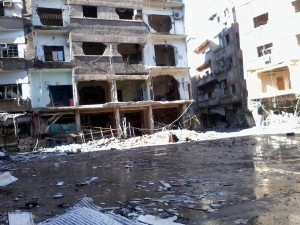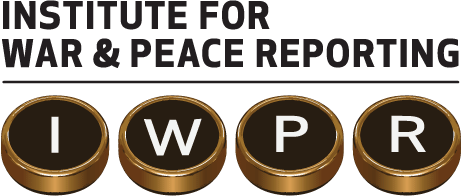Yarmouk Caught Between Shelling and Siege

I entered the Yarmouk refugee camp on foot, taking the bridge. I was accompanied by a young Syrian journalist and an aid worker who warned me: “If we don’t manage to get out before 2 p.m. we’ll become targets for the snipers spread out along the edges of the camp.” 
It is not that the snipers abide by a strict timetable, he explained, but at least before 2 the streets are crowded, offering some protection.
The camp is located on the south side of Damascus. It is comprised of two main streets, Yarmouk Camp Street and Palestine Camp Street, and was a major commercial centre for southern Damascus. There were two checkpoints manned by fighters from the Popular Front for the Liberation of Palestine-General Command led by Ahmed Jibril – one by the bridge, and the second on Nisrine Street next to Al- Bashir Mosque. We were able to cross the bridge checkpoint easily.
On Yarmouk Camp Street, all the stores were shuttered, and the streets nearly devoid of pedestrians and cars. Piles of garbage and waste lined the street. But apart from a few damaged buildings and shops here and there, the damage was limited.
But when I got to the Regie Square, just 600 meters from the main entrance of the camp, I was struck by the scene of destruction. The square had been targeted by a car bomb in early December. The area is now controlled by a Free Syrian Army, FSA, faction known as Liwaa’ Al-Haq (The Brigade of the Righteous). I wanted to take a picture of the ruined square, but I was shaking with fear that I would be shot by a sniper from the regime’s army. I was surprised when one of the fighters from Liwaa’ Al-Haq tried to prevent me from taking a picture without giving a clear reason. Even though the picture was only of a ruined building, the fighter insisted on confiscating my mobile phone and deleting some of the pictures. He told me he was responsible for the brigade’s Facebook group, and that I could get pictures from there. 
“Do they have a monopoly on photographing the destruction?” I thought to myself.
The camp was almost completely still. Taxi drivers are afraid to enter the area due to the shelling, clashes and rigorous searches at the checkpoints entering the camp, so camp residents rely on a new form of transportation: small Suzuki pick-up trucks. The trucks’ owners volunteer to move people and help them reach areas inside the camp, as I had the occasion to witness when I saw a man flag down one of these trucks, which stopped to pick him up.
In the few short hours I was able to spend in the camp, I visited the headquarters of the Jafra association, a grassroots group that delivers aid and medical services. There, I spoke with some of the families who can come to ask for assistance and food supplies. I noticed some were complaining because they had not received their aid when they were supposed to.
Jafra’s media coordinator Osama, 26, said that although there are organizations that give out aid, the difficulty lies in getting goods into the besieged camp. According to Osama, Jafra had appealed to the General Board for Refugees which is responsible for the camps and falls under the Ministry of Labour and Social Affairs to ease the flow of aid through the checkpoints, but to no avail. 
“It totally depends on the mood of those manning the checkpoint,” he said. “They can refuse to let in aid on the grounds that it’s going to the Free Syrian Army even though 90% of the camp residents are civilians and the Free Syrian Army is only in a few specific places. But the soldiers at the checkpoint [act] like God, and are not ready to let in aid despite the approval of the General Association for Refugees.”
The confusion was evident on the faces of the families gathered at Jafra awaiting food supplies.
I spoke to Hiba, who lives with her husband, two sons and daughter along with six other families in a single two-bedroom house.
“We can bear the suffering, but our children are innocent,” she said. “There is no bread, no electricity, no heating, and no shelter. My house on Safad Street was shelled.”
“Even if one of the markets were open, we can’t buy anything because we have no money,” she continued. “When the Yarmouk bakery does open, it sells a bag of bread for 100 Syrian Pounds (1.4 US dollars). If we had money we would have left to save our lives, but it seems death only comes for poor people like us.”
During my tour through the streets of Yarmouk I was stopped in my tracks by the sight of the Palestinian Liberation Organization’s Fayez Halawa Clinic, which was closed, its windows shattered.
Hassan Mustapha, 28, who works at Jafra, said that not only was the Halawa Clinic hit by a shell which broke all the windows, the Bassel Clinic was also hit by two shells, damaging the lighting and medical equipment.
“Palestine Clinic is the only one taking patients, but it is suffering from serious shortages of medical supplies,” said Mustapha. “And despite the assistance offered by the aid organizations in the camp, we need help from the international community. The siege on the camp must be lifted so we can get medical supplies.”
“The situation is going from bad to worse and we don’t have any cards to play, not with the Free Syrian Army nor with the regular army, in order to make the civilian areas safer,” he said, adding that the movement of aid workers and first responders, who are being targeted daily, should be secured.
On January 7, Ahmed Kousa, one of the aid workers with the organization Basma, was killed in the line of duty by a sniper in the Regie Square. Unfortunately, he is not the first aid worker to be targeted.
The Charity Organization for the Relief of the Palestinian People, which is affiliated with Islamic Jihad movement, lost four of its workers, despite being licensed by the Syrian government. Another volunteer with the Civil Defence team working with Jafra was also killed by a sniper, even though he was wearing the uniform identifying him as an aid worker at the time.
